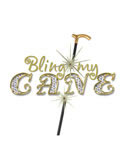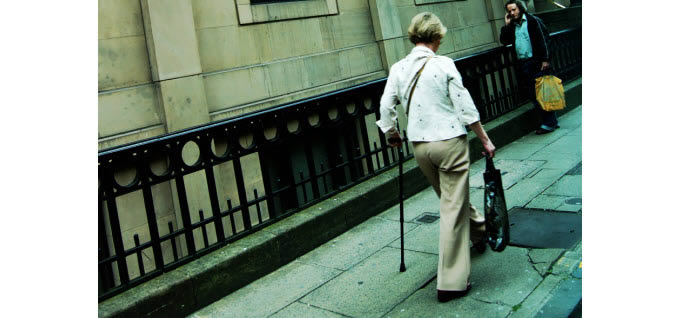I Will Not Use a Walking Cane!
Walking Cane Safety Step 3 – Choosing the Safest Grip and Tips for Your Walking Cane
Believing that canes are unsafe for seniors, my friend Sophia has been reluctant to even consider using one when walking outside her home. She is a healthy 78-year-old, except for a weak left knee, and she enjoys life. Sophia does not want to look like “an old lady” when she ventures forth and does not consider a cane to be a fashion accessory. As her friend, I can understand her concerns but I know if she could see that the many different types and styles of walking canes available today are both safe and fashionable, she would enjoy using a walking cane.
We have properly measured Sophia for a cane, see Walking Cane Safety Step No. 1 – Fitting You for a Walking Cane, and we have looked at the many different types and styles of canes that will make her feel safe and secure, see Walking Cane Safety Step No. 2 – Choosing the Type and Style of Walking Cane for Safe Support. Sophia has seen that if she were to choose a cane type that made her feel secure she might be willing to consider actually using a cane and not feel that they were dangerous. It is time now to look at the types and styles of cane handles (or grips) and ferrules (or tips) that can provide her with the safest support.
Walking Cane Handle Grip Types to Choose for Safe Support
1. Crook handle canes are generally for those with a slight or temporary injury or who need a little extra support for a short period of time. Crook handled canes are usually the least expensive of the canes and are frequently what a person considers to be the typical cane. They are not, not any more.
2. Derby handle canes provide additional support as the handle, being straighter, is much easier to grip than a crook handle cane. Derby grips can be a favorite for anyone suffering from arthritis or anyone with a smaller hand. By ensuring a person’s weight is over the shaft of the cane, this type of grip helps to provide more support to the user. By providing a more comfortable grip, Derby canes provide a steadier walk to users. Derby handled canes are straight-handled canes (similar to Fritz handled canes) that come in many colors and materials.
3. Fritz handle canes. Fritz handles, although similar to the Derby handles, are generally smaller compared to other handle styles. Many classy canes have fritz handles in wood, marble, metal or Lucite materials.
4. Ergonomic handles are molded to fit the hand and evenly distribute body weight over the surface of the handle and over the shaft of the cane. ‘Ergonomic’ or ‘anatomically-correct’ handles are made to minimize pain to the wrist and hand due to improper holding of the cane. They are often specifically made for left or right hand use. Ergonomic cushion-top handles are quite attractive, offering both safety and style to the walking cane enthusiast.
5. Ornamental handles are for the more leisurely user seeking an attractive style or unique cane. Ornamental grips are ideal for canes for special occasions; they are perfect as fashionable accessories and are great as gifts. Many walking cane collectors seek out unique ornamental handled canes to add to their collection.
Walking Cane Tip Styles to Choose for Safe Support
When walking canes were first made they had brass or copper tips to protect the cane shaft from wear. Due to the likelihood of slipping, brass or copper are not used for walking cane tips today. Today, we use removable and replaceable ferrules (cane tips) that come in different types and styles for walking cane safety.
1. Rubber tips: The tip or bottom of the walking cane is usually covered in rubber to provide better stability. These tips are bell-shaped with a recessed base for better traction and are reinforced with a steel insert for optimum durability. Rubber tips can be removed to use other types of tips such as ice grippers in snowy conditions. You should check your walking cane tip frequently to ensure it is in good condition. A worn or torn rubber tip is dangerous and easily and inexpensively replaced. Rubber tips come in different sizes depending on the cane shaft diameter and can usually be purchased in packages of 2-6 tips at a time.
2. Quad tips: The tip of quad canes have four ferrules at the bottom instead of just one. This enables them to carry more weight, often up to 300 lbs. Quad tips are made of heavy-gauge anodized aluminum which are light weight but extremely durable. These quad bases come in large and small sizes to suit your needs. By being shaped like the letter “K”, they offer greater stability and safety while being used close to the body. These quad cane tips can be easily rotated and locked into place for use in the left or right hand.
3. The new QuadPod ultra stable cane tip provides increased safety and stability with a smaller and lighter quad tip. The QuadPod’s unique design recenters itself for maximum stability and allows your cane to stand independently. Unlike a typical quad cane that lifts and sets on a 4-prong base, the QuadPod’s more uniform stable surface enabling a more natural gait, so you can go anywhere you want to go!
4. Ice grippers: A built-in retractable metal ice tip can be engaged with the push of a button. Or you can use ICE GRIPPERS THAT SECURELY ATTACH TO CANES (AND CRUTCHES) PROVIDING EXTRA GRIP AND STABILITY ON A VARIETY OF SURFACES. The attachment ice grip is secure and easy to install and simply flips down to use and flips up again when not in use. Ice grippers come with one ice prong or five ice prongs and are extremely handy when you want to get out in the fresh air even when there is snow on the ground.
5. Snow Grabbers: Although not strictly walking cane accessories, snow grabbers are shoe and boot wrappers (grips) that are used by those who want to walk and jog in winter. They provide excellent traction and increased security for walking cane users as well. They come in various sizes for both men and women whether wearing boots or shoes. It is their specially designed non-slip studs that provide the extra security when using a walking cane in winter.
WHEN USING A WALKING CANE, SAFETY COMES FIRST
Just as it is important to fit you for a cane, it is important to choose a cane grip (handle) that is comfortable, fits your hand well, and distributes your weight properly. By giving some extra thought to the type of cane tip you will use, you will also feel safe and secure when enjoying your walking cane outdoors in all kinds of weather.
Having seen the incredible variety of walking cane grips and tips, Sophia was now quite excited about the thought of using a cane. But still, lingering in the back of her mind was the feeling of looking “old” and “feeble” when using a cane. Although impressed with the many styles and colors of cane handles and tips, and especially the varied and colorful shafts from which to choose, she felt she needed something more. So, instead of taking her to the next logical step in choosing and using a walking cane (learning how to walk safely with a walking cane), I told her about the many fancy and unique canes that were available today.

SOPHIA AND I DECIDED THAT TOMORROW WE WOULD LOOK AT SOME WALKING CANE “BLING!”





 and get Cash rewards!
and get Cash rewards!